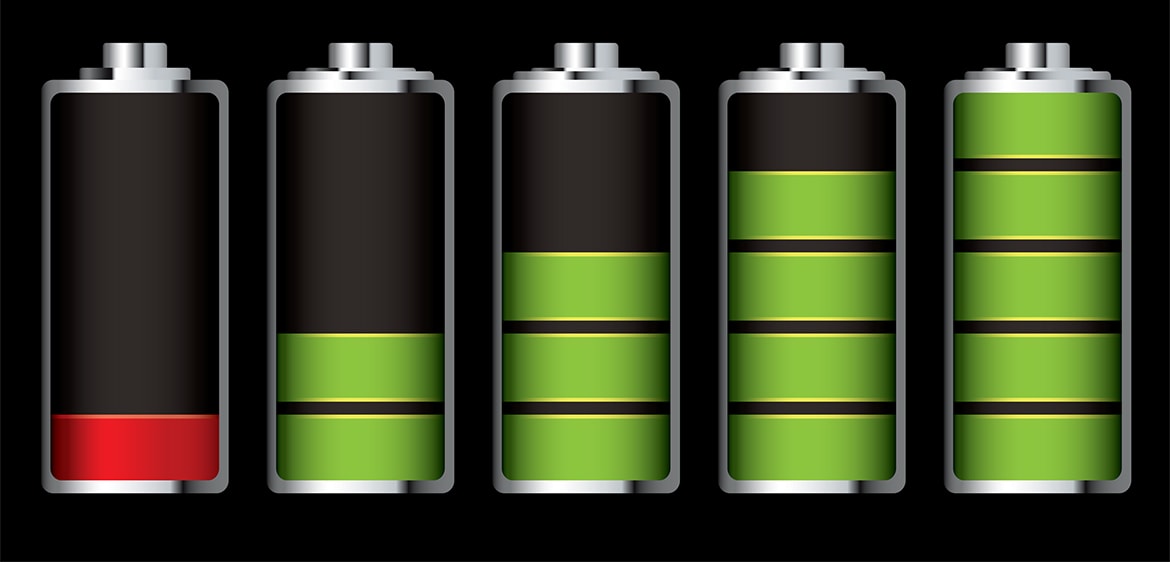Battery Basics
Fundamentals of Battery Technology
What is a battery?
A battery, in concept, can be any device that stores energy for later use. A rock, pushed to the top of a hill, can be considered a kind of battery, since all the energy used to push it up the hill (chemical energy, from muscles or combustion engines) is converted and stored as potential energy at the top of the hill. Later, that energy is released as kinetic and thermal energy when the rock rolls down the hill.
Common use of the word “battery”, however, is limited to an electrochemical device that converts chemical energy into electricity, by use of a galvanic cell. A galvanic cell is a fairly simple device consisting of two electrodes (an anode and a cathode) and an electrolytic solution. Batteries consist of one or more galvanic cells.
How does a battery work?
Figure 1 shows a simple galvanic cell. Electrodes (two plates, each made from a different kind of metal or metallic compound) are placed in an electrolytic solution. External wires connect the electrodes to an electrical load (a light bulb in this case). The metal in the anode (the negative terminal) oxidizes (i.e. it “rusts”), releasing negatively charged electrons and positively charged metal ions. The electrons travel through the wire (and the electrical load) to the cathode (the positive terminal). The electrons combine with the material in the cathode. This combination process is called reduction, and it releases a negatively charged metal-oxide ion. At the interface with the electrolyte, this ion causes a water molecule to split into a hydrogen ion and a hydroxide ion. The positively charged hydrogen ion combines with the negatively charged metal-oxide ion and becomes inert. The negatively charged hydroxide ion flows through the electrolyte to the anode where it combines with the positively charged metal ion, forming a water molecule and a metal oxide molecule.
In effect, metal ions from the anode will “dissolve” into the electrolyte solution while hydrogen molecules from the electrolyte are deposited onto the cathode.
When the anode is fully oxidized or the cathode is fully reduced, the chemical reaction will stop and the battery is considered to be discharged.
Recharging a battery is usually a matter of externally applying a voltage across the plates to reverse the chemical process. Some chemical reactions, however, are difficult or impossible to reverse. Cells with irreversible reactions are commonly known as primary cells, while cells with reversible reactions are known as secondary cells. It is dangerous to attempt to recharge primary cells.
The amount of voltage and current that a galvanic cell produces is directly related to the types of materials used in the electrodes and the electrolyte. The length of time the cell can produce that voltage and current is related to the amount of active material in the cell and the cell’s design.
Every metal or metal compound has an electromotive force, which is the propensity of the metal to gain or lose electrons in relation to another material. Compounds with a positive electromotive force will make good anodes and those with a negative force will make good cathodes. The larger the difference between the electromotive forces of the anode and cathode, the greater the amount of energy that can be produced by the cell. Table 1 shows the electromotive force of some common battery components.
| Anode Materials Listed worst (most +) to best (most -) |
Cathode Materials Listed best (most +) to worst (most -) |
| Gold | Ferrate |
| Platinum | Iron Oxide |
| Mercury | Cuprous Oxide |
| Palladium | Iodate |
| Silver | Cupric Oxide |
| Copper | Mercuric Oxide |
| Hydrogen | Cobaltic Oxide |
| Lead | Manganese Dioxide |
| Tin | Lead Dioxide |
| Nickel | Silver Oxide |
| Iron | Oxygen |
| Chromium | Nickel Oxyhydroxide |
| Zinc | Nickel Dioxide |
| Aluminum | Silver Peroxide |
| Magnesium | Permanganate |
| Lithium | Bromate |
Table 1: Electromotive Series for some battery components
Over the years, battery specialists have experimented with many different combinations of materials and have generally tried to balance the potential energy output of a battery with the costs of manufacturing the battery. Other factors, such as battery weight, shelf life and environmental impact, also enter into a battery’s design.
Galvanic Cells vs. Batteries
A Battery is one or more Galvanic Cells connected in series or in parallel. A battery composed of two 1.5 V galvanic cells connected in series, for example, will produce 3 V. A typical 9 V battery is simply six 1.5 V cells connected in series. Such a series battery, however, will produce a current that is equivalent to just one of the galvanic cells.
A battery composed of two 1.5 V galvanic cells connected in parallel, on the other hand, will still produce a voltage of 1.5 V, but the current provided can be double the current that just one cell would create. Such a battery can provide current twice as long as a single cell.
Many galvanic cells can be thus connected to create a battery with almost any current at any voltage level.







